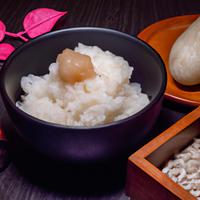
1 serving (100 grams) contains 97 calories, 2.0 grams of protein, 0.2 grams of fat, and 21.1 grams of carbohydrates.

Log this food in SnapCalorie

Nutrition Information
Calories |
194 | ||
|---|---|---|---|
% Daily Value* |
|||
| Total Fat | 0.4 g | 0% | |
| Saturated Fat | 0.2 g | 1% | |
| Polyunsaturated Fat | 0 g | ||
| Cholesterol | 0 mg | 0% | |
| Sodium | 2 mg | 0% | |
| Total Carbohydrates | 42.2 g | 15% | |
| Dietary Fiber | 0.6 g | 2% | |
| Sugars | 0.2 g | ||
| protein | 4 g | 8% | |
| Vitamin D | 0 mcg | 0% | |
| Calcium | 6 mg | 0% | |
| Iron | 0.4 mg | 2% | |
| Potassium | 24 mg | 0% | |
* Percent Daily Values are based on a 2,000 calorie diet. Your daily values may be higher or lower depending on your calorie needs.
Food Attributes
Source of Calories
About Cooked glutinous rice
Cooked glutinous rice, also known as sticky rice, is a staple in many Asian cuisines, including Thai, Chinese, and Japanese. Made from short-grain glutinous rice, it is prepared by steaming or boiling after soaking, resulting in its distinct chewy texture. Despite its name, it contains no gluten but is high in carbohydrates, making it a quick energy source. Rich in manganese, it supports bone health and metabolic functions. Glutinous rice is naturally low in fat, sodium, and cholesterol, aligning with heart-healthy dietary goals. However, its high glycemic index means cautious consumption is advised for individuals managing blood sugar levels. This versatile ingredient is used in both savory dishes and sweet treats, such as mango sticky rice and rice cakes. While nutritious in moderation, it’s best paired with fiber-rich foods to balance its carb-heavy profile.



